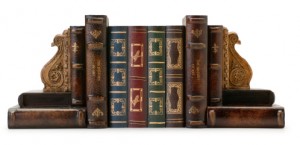Tag: Historical Novel Society
An Amazing Time in San Antonio: The Historical Novel Society North American Conference 2023
Hello dear readers! I am just back from the biannual North American HNS conference. Bit of trivia—I’ve attended every American HNS conference since the very first, held in Salt Lake City in 2005. Back then I was still working on my first manuscript and had no agent yet. Over my three days in Utah and I learned so much about the industry! To this day I consider the HNS conferences an indispensable event for staying up to speed on the publishing industry and gaining insights into the craft of writing for those of us writing in the historical genre. They are also a heck of a lot of fun.
I was a panelist in San Antonio, discussing the logistics of pen names—their creation, branding and management—along with the talented Eliza Knight, Libbie Grant and Kris Waldherr. Our panel had a specific focus on using multiple pen names, which means I got to be both Sophie Perinot and Evie Hawtrey in the same place at the same time (a first)!
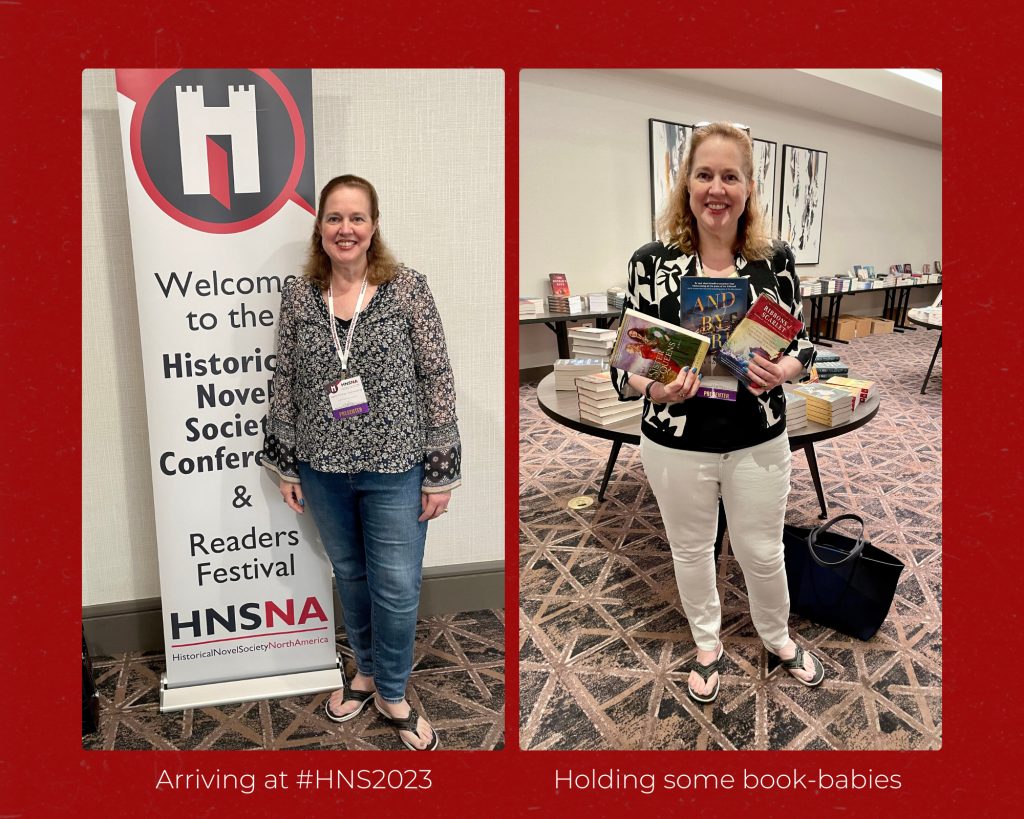
Below you will find some photo highlights of the conference, featuring myself and other historical fiction authors you likely read, as well some of what we got up to. Enjoy! I certainly did!
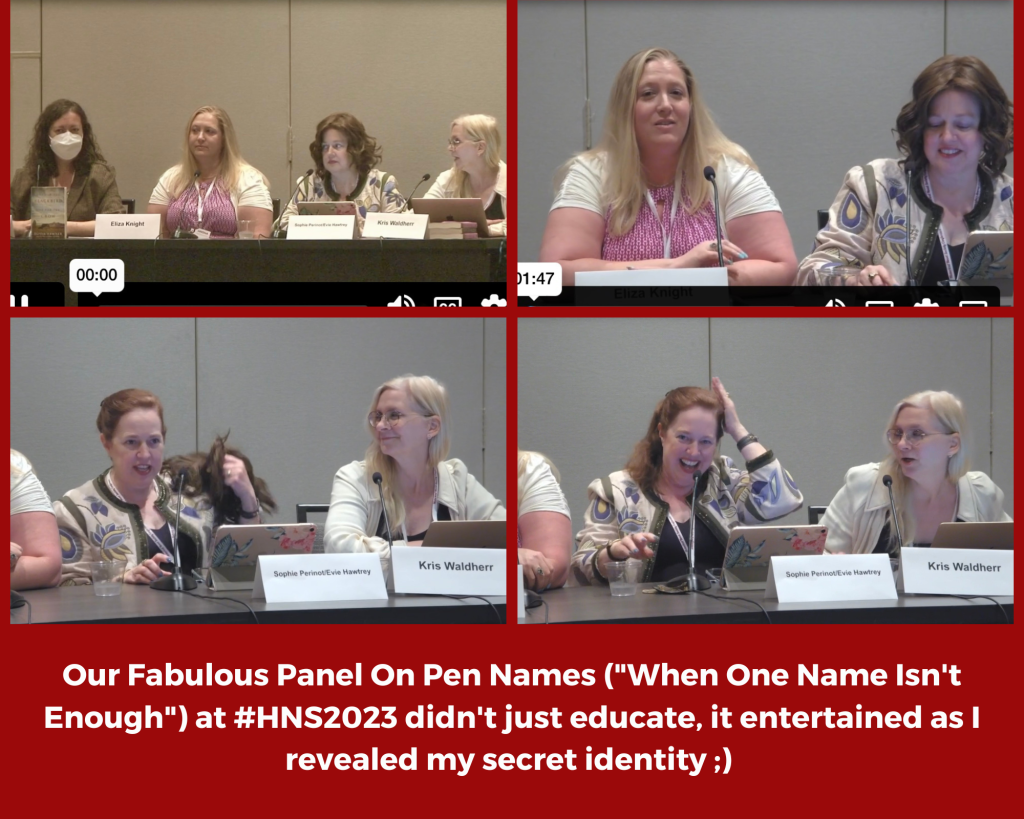
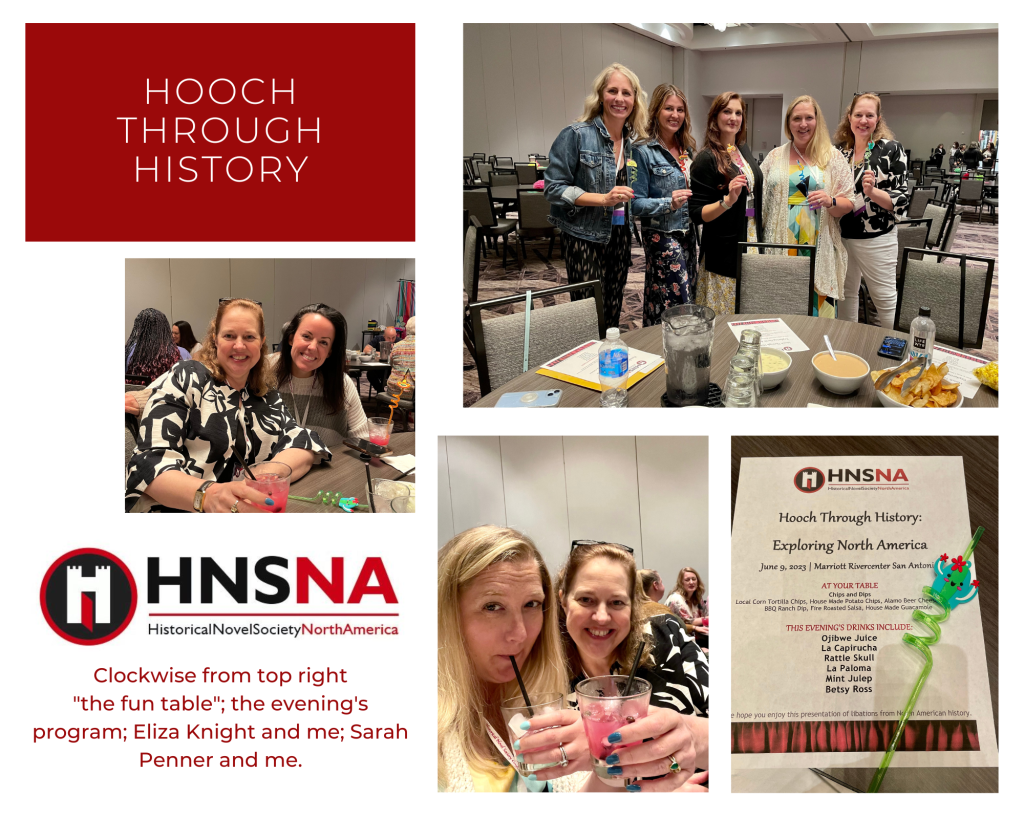

Clockwise from top left: Eliza Knight, Heather Webb and me; cotton candy cocktail; Mariah Fredericks, Karen Odden and Judith Starkston; margaritas; Karen Odden and me; Kate Khavari and me; best guacamole ever. And right smack in the center–Nancy Bilyeau and me.

Historical Novel Society Conference Teaser—Meet HNS Panelist Nancy Bilyeau
In less than a month I will be off to the 5th North American Historical Novel Society Conference in St. Petersburg Florida, where I will be sitting on two panels—“Location, Location, Location” (discussing how setting is the mortar board upon which historical novels are built and tackling topics related to recreating period locations); and “The Feisty Heroine Sold into Marriage Who Hates Bear Baiting: Clichés in HF and How to Avoid Them” (title of this one says it all). 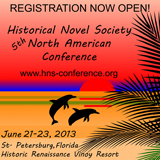
Those of you who were kicking around this then-new blog 2 years ago know what my conference attendance means. . .lots of juicy post-event blogging on trends in the genre and topics of historical fiction interest. But why should you wait until after? How about a conference teaser—an interview reunion with HNS panelist, Nancy Bilyeau.
Nancy is the author of a pair of marvelous historical thrillers following the adventures of novice nun, Joanna Stafford, as she seeks to survive and thrive in Henry VIII’s England while the monasteries are dissolved around her. Nancy’s first book, The Crown, released in 2012 to immediate critical acclaim. “O” (The Oprah Magazine) called it, “A juicy blend of lust, murder, conspiracy, and betrayal.” Nancy’s second book, The Chalice, released this past spring to the eager embrace of existing fans and new ones alike.
Nancy last visited me immediately after the release of her debut novel. I present for your pleasure an update to that interview.
1) Since we last sat down together in our virtual chairs your second novel, The Chalice, came out. Can you tell us a little bit about the new book?
In the second book, it’s 1538, and my main character, Joanna Stafford, is caught in the crosswinds of time. She is a Dominican novice without a nunnery—Henry VIII has broken with Rome, and all the monasteries have been seized. Joanna must decide what path to follow now, and while she seeks a quiet life of tapestry weaving and raising her orphaned relative, Arthur, the kingdom is far from stable. There is a conspiracy against the king, one revolving around prophecy, and Joanna is targeted by those who want Henry VIII off the throne. She learns that the prophecy is about her – and an act she must take in the future, one that could be very dark and dangerous. So the conflict of the book is: If you loved something very much and you had a chance to save it but to do so you must commit an act that is perhaps unforgivable, would you do it? 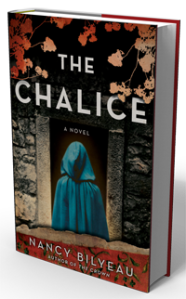
2) inspired you to choose a fictional Dominican nun as the heroine of your series?
I first chose to set a book in the 16th century—simply because it is my favorite century from history. I love mysteries and thrillers, and wanted to attempt to write one with a female protagonist. It took me a long time to figure out who would be the person. I didn’t want a royal or lady in waiting, yet someone living in a Tudor village, I feared it would be too hard to inject that woman into conflict that rises to the level of a thriller. A nun struggling for her future in the middle of the Dissolution of the Monasteries—when the Catholic Church was being violently dismantled—could be quite compelling. Finally, I picked a Dominican because there was only one such order in England, and that made it special.
3) I found it refreshing that Joanna stayed “in character”—true to the religious sentiments one would expect a 16th century nun to have. How difficult was it for you to achieve that? Do you think it was a risky choice given you are writing for a modern—and generally rather skeptical—audience?
One of my pet peeves is characters in historical novels who have modern sensibilities. It’s the easy way out. There is some strange part of my personality that compels me toward the most difficult choices. Sometimes I wish it were otherwise! But as soon as I decided on a nun, I was determined to make her authentic to the spiritual values of the period. I didn’t want to write a book with a reluctant nun who is forced into it by her father or retreats to a priory after rejection by a man. Again, that’s the easy way out. I did worry that readers would be turned off by a spiritual woman but I’ve not seen that reaction. Readers of historical fiction are eager for authentic behavior, I’m more convinced of that than ever. Commit anachronisms at your peril!
The way I tried to achieve it was reading what women in religious orders actually wrote: Catherine of Siena, Hildegarde of Bingen, Teresa of Avila. That helped get me in the proper mood. Also a writing teacher recommended I research the lives of the early female Catholic saints, the ones who were torn to pieces in the Roman Coliseum or who became martyrs in the Dark Ages and medieval period. The thinking of these women is about as far from a 21st century mindset as you can get. Just fascinating. 
4) Besides Joanna, who is your favorite character in the series? Who is your least favorite? Why?
Brother Edmund is my second favorite—I like to think that he is a pretty original character and for some reason I have tremendous sympathy for him. He’s a mix of strengths and weaknesses. I tried my best to make all the characters nuanced. I don’t like two-dimensional people hurtling through thrillers. Or characters with worn-out identifying descriptions: a natural beauty, a strong-jawed man. Ugh.
My least favorite character? Hmmmm. That’s an interesting question. Did I create a character I personally would dislike? Apart from George Boleyn—and I can’t give away why I wouldn’t want to have encountered him at a tender age, or else that would be a spoiler—it would have to be the young prioress in The Crown. She was inspired by a boss I once had—a very difficult one. In fact, I drew on my personal work history, my years in the magazine business, when depicting life in the priory. I thought about it a lot, and decided that though the stereotype of a nunnery was of graceful, serene ladies floating down the halls in harmony, I imagined that there would be the rivalries and tensions found in any group of people essentially working together, and in this case living together too. I was very happy to receive an email from a Dominican nun and two emails from friars that said I captured correctly the essential feeling of life in an enclosed religious community.
5) Truth is often stranger than fiction. In our last talk I asked you about interesting discoveries made while researching The Crown. When you set out to write its sequel, The Chalice, what was the most unusual or unexpected thing you discovered in that process?
I was stunned by how much belief there was in astrology, alchemy and prophecy, from the highest levels of society to the lowest. The mid-16th century was a very mystical time.
6) Writing a series presents special challenges to an author. What, in your opinion, is the most difficult aspect of writing sequential novels? The most rewarding?
The most rewarding aspect is that I love my characters and I want to write them in new situations, whether it’s political crisis or romantic entanglement. I just enjoy spending my time with these people! As for the hardest, well, I am trying to write these books for someone who has never read the ones that come before and also for the fans of the series. It’s hard to serve both kinds of readers.
7) I know you are hard at work on the final book in this series. What will it be called and can you share a bit about it?
I’m excited to share with you that Simon & Schuster has bought the third book. It is called The Covenant. Joanna Stafford finally returns to the court of Henry VIII—and nearly pays for that decision with her life. Someone is trying to kill her and she doesn’t know who. If you’ve read the first two books, you know that there are enough people to form a line. LOL. Also, Joanna will travel outside of England, as she did in The Chalice, but farther this time. And she will make a definitive decision on how she plans to spend the rest of her life, and with whom.
8) In The Crown Joanna brushes elbows with a number of famous historical characters like Catherine Howard and Stephen Gardiner, Bishop of Winchester. In The Chalice you treated us to a face-to-face encounter between Joanna and Thomas Cromwell. Who might we meet in book three?
In The Covenant, many things are going to come to a head that I have been writing about in The Crown and The Chalice. Joanna is a weaver of tapestries and Henry VIII is the most avid collector of tapestries in Europe (that’s true!), and so she will be pulled into the court and the inner circle of the king. Catherine Howard will play a larger role in the third book, which shouldn’t surprise those knowledgeable of history, but readers will see a new side to her and also get to know a much different Thomas Culpepper than has been depicted before. Joanna will stand up to Bishop Gardiner and the duke of Norfolk in this book! And there will be some surprises too. Just as in The Chalice I brought in a character contemporary to this time not usually associated with the Tudors, I have a plan for two other fascinating folks.
9) Like myself, you will be a panelist at the upcoming Historical Novel Society Conference, what is the topic of your panel and what can attendees look forward to learning if they attend?
The name of the panel is “Making It in the Mainstream and What Comes After.” I am honored to be on the same panel as Patricia Bracewell, Deborah Swift, Jenny Barden and Gillian Bagwell. We’re going to talk about what brought us this far and how we plan to keep going.
 About Nancy: Nancy Bilyeau is a writer and magazine editor who has worked on the staffs of InStyle, Rolling Stone, and Ladies’ Home Journal. She is currently the executive editor of DuJour magazine. She was born in Chicago and grew up in Michigan, earning a bachelor’s degree from the University of Michigan. Now she lives in New York City with her husband and two children. Her first novel, The Crown, was nominated for an Ellis Peters Historical Dagger Award 2012 by the Crime Writers’ Association, given to Best Historical Crime Novel.
About Nancy: Nancy Bilyeau is a writer and magazine editor who has worked on the staffs of InStyle, Rolling Stone, and Ladies’ Home Journal. She is currently the executive editor of DuJour magazine. She was born in Chicago and grew up in Michigan, earning a bachelor’s degree from the University of Michigan. Now she lives in New York City with her husband and two children. Her first novel, The Crown, was nominated for an Ellis Peters Historical Dagger Award 2012 by the Crime Writers’ Association, given to Best Historical Crime Novel.
Interview at the Pittsburgh Historical Fiction Examiner
Today I am delighted to be a guest at Pittsburgh Historical Fiction Examiner. A special thank you to Kayla for inviting me to follow in the virtual footsteps of such historical fiction favorites as C.W. Gortner, Juliet Grey, Donna Russo Morin, Gillian Bagwell and Christy English. I am also grateful for Kayla’s insightful interview questions and hope you (oh faithful blog readers) will enjoy them as well.
Historical Fiction Coming Attractions
Up Close and Personal (sorry for the coffee breath)
As those of you who follow me on twitter know, I learned a lot at 4th North American Historical Novel Society Conference in San Diego last month (see—I didn’t just spend my time drinking in the hotel lobby). I even had a number of “ah ha” moments.
One of those happened early on, when a publishing industry insider said, “The author to reader connection is closer than it has ever been.” Now admittedly this was a bit more of a “duh” moment than an “ah ha” moment as it was happening because if there is one thing a writer knows (even a newbie like me) it’s that in this era of social-media we are expected to network with our potential readers. But knowing something being able to act on it effectively isn’t always the same thing.
What does it mean to “be accessible to our readers?” How can we turn the monologue (I blog, I tweet, I facebook, therefore I am) into a dialogue? How can I improve your experience—of this website and ultimately of my book?
It was while thinking about these questions that the “ah ha” bit happened (or more precisely while thinking about these questions and not coming up with any clever answers) —ask readers. AH HA!!!
So, what do you think? What would you like to read about here in blog-land? What do you like about this place and what needs some improving? Do you follow me on twitter, and, if so, how would you whip @lit_gal into shape if you were given access to a whip? What can I or should I be doing to improve your experience as a reader (of this blog and soon, I hope, of The Sister Queens)?
Give Me A Little Kiss – Sex and the Historical Novelist
There is nothing new about sex. Birds do it, bees do it, and our ancestors most certainly did it (to butcher Cole Porter’s lyrics inexcusably).
What IS relatively new is the amount of sex appearing in “straight” historical fiction (I use this term to distinguish historical fiction from historical romance, not to imply that only heterosexual hanky-panky is included). If memory serves, the historical novels of my youth did a lot of fading-to-black. But somewhere between my decision to become a writer and my first book deal a shift occurred. Today there are plenty of sex scenes in straight historicals—some of them quite explicit. And sex seems to be a popular addition. For example, a video recorded at this year’s Historical Novel Society Conference during a popular event called “Late-Night Sex Scene Readings” (the reading of a scene from Gillian Bagwell’s The Darling Strumpet) has received over 6,000 hits on youtube since June.
Opinions on this trend vary. Here is mine: the inclusion of sex in historical novels is neither good nor bad in a vacuum. It’s not the sexual content that determines whether a particular scene works—it’s whether that scene (sex or otherwise) has a REASON for being in the novel. Tossing in an orgy (or even a kiss) into your work of historical fiction without a solid reason is a bad idea. The scene will feel “added on,” and gratuitous sex is no more acceptable in a novel than gratuitous dialogue.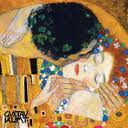
So what can intimate scenes sometimes do well?
Forward the plot. Yep, just like any other sort of action a sex scene can move a novel’s plot forward. For example, one of my manuscripts includes the seduction of a royal courier for the purpose of getting a letter into his satchel. This letter is an important step on the path to the book’s central climax. So the sex scene (in a stable and pretty exciting in its own right, I might add) is vital to the forward motion of the novel.
Flesh out (sorry, I just HAD to) relationships between characters and/or give us emotional insights into characters. Sex, as we know from real life (or at least some of us know – no pressure on or disrespect to celibates reading this), is seldom merely a physical act. It has emotional ramifications, and can be a language all its own. So, a sex scene in a novel (whether vague or graphic) can be effectively used to give readers a sense of how characters relate to each other. For example, in my debut novel, The Sister Queens, readers learn a tremendous amount about one of my female characters and her relationships with two separate men simply by the contrast between her sexual experiences with each.
Help set the story firmly in its historical period. Sexual politics, mores, and practices change over time. For example, in certain periods, a man’s dominion over his wife’s body was complete – there was no such thing as rape between a man and his wife. Likewise, for hundreds of years sex (seduction, withholding of, etc) was one of the few tools available to a woman seeking power or influence. While today we would surely condemn a man for taking his wife by force and likely censure a woman for using sex to get ahead, seeing either such event a depicted in a historical novel reminds readers of the realities of the past and of our characters’ lives.
Beyond raising large issues of this sort, the inclusion of period details pertaining to sex—the acceptable positions for intercourse, its prohibition on certain days, the forms of birth control that were or were not available—can help build the “historical world” of the novel just as the inclusion of other period details can. In my novel frequent reference is made to payment of the “marriage debt,” and one of my female protagonists feels wronged when her husband spurns intercourse with her. As a matter of history she was entitled to feel gypped because, under the doctrine of the medieval Church, a married man was obliged, under penalty of mortal sin, to give his wife sex as a preventative measure against temptation to sins like fornication and adultery.
Give the reader a thrill. Yep, this one is legitimate too. But wait, Sophie, you are thinking, “you wrote five paragraphs ago that gratuitous sex is not acceptable.” Since when, dear writer, is giving the reader a bit of fun gratuitous? Meeting the needs of the reader is our business. We meet needs for escape. We meet emotional needs. We help readers wrestle with difficult questions in their lives. For heaven’s sake why should meeting readers’ needs for a bit of titillation be off the table? And why should meeting that need be solely the province of historical romance? Plenty of contemporary novels—from thrillers to literary fiction—include sex. I believe that writers working anywhere along the historical genre continuum should feel free to include intimate moments as well.
What do you think? Would you prefer to see explicit sex kept for historical romances alone? Can the inclusion of sex in a straight historical novels can be a positive addition?
Invention is the Midwife of Good Historical Fiction
Necessity may be the mother of invention, but invention is the midwife of good historical fiction.
Invention and creativity are good things. But in historical fiction we (writers) sometimes lose sight of that, and get bogged down in the minutiae of our period and the thousand little details in our characters’ lives. I was recently reminded, with force, that readers come to authors of historical fiction for something more than a collection of facts.
I had the opportunity to hear Susan Vreeland, a master of the genre, speak at a recent Historical Novel Society Conference. I thought Susan was going to do a presentation on her latest book. But, when we were gathered before her in our neat little rows, she decided to tackle a larger issue – the role of invention in historical fiction.
“Don’t be tyrannized by fact.” That’s how Susan opened her presentation. And she is right of course. Historical fiction is not academic history. Does accuracy matter in historical novels? You bet your farthingale it does but, “fictional art can show truth that goes deeper than a collection of fact; it can show us what it felt like to be a particular person at a particular time” (again, Susan V). Besides, “as soon as something happens people start lying about it” (Cecelia Holland) so “truth” in history can legitimately be debated.
Susan pointed out that selection (and correspondingly, elimination) of facts is part of the process of writing compelling historical fiction. Good authors know instinctively – whether they write historical fiction or another genre – that telling just the right bits is what gives a great story its focus. Authors of historical novels must choose only those events from history that relate to the specific premise/themes of their particular novel. It doesn’t matter how interesting an event is (or how pivotal it is in the life of a historical character), if that event doesn’t forward the plot of the book an author is writing, then it needs to be left out. There were dozens of interesting events in the lives of my main characters, Marguerite and Eleanor of Provence, during the twenty-year period covered by The Sister Queens that did not make it into my novel because they were not germane to the “sisters” theme of my book. Continue reading Invention is the Midwife of Good Historical Fiction
